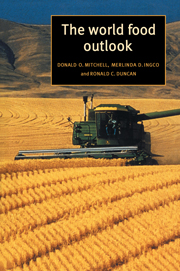Book contents
- Frontmatter
- Contents
- List of figures
- List of tables
- Preface
- List of abbreviations
- 1 The world food problem
- 2 The price of food
- 3 Gains in consumption levels
- 4 World food production increases
- 5 Population growth and food demand
- 6 The quantity and quality of the resource base
- 7 Raising yields
- 8 Changing consumption patterns
- 9 Simulating the future world food situation
- 10 The world can feed twice as many in twenty years
- 11 A robust prediction?
- 12 Africa presents a special challenge at the turn of the century
- Appendix The World Grains Model
- References
- Index
4 - World food production increases
Published online by Cambridge University Press: 06 November 2009
- Frontmatter
- Contents
- List of figures
- List of tables
- Preface
- List of abbreviations
- 1 The world food problem
- 2 The price of food
- 3 Gains in consumption levels
- 4 World food production increases
- 5 Population growth and food demand
- 6 The quantity and quality of the resource base
- 7 Raising yields
- 8 Changing consumption patterns
- 9 Simulating the future world food situation
- 10 The world can feed twice as many in twenty years
- 11 A robust prediction?
- 12 Africa presents a special challenge at the turn of the century
- Appendix The World Grains Model
- References
- Index
Summary
A third indicator of the world food situation is domestic food production (or output) as it is the major source of food in most economies. In economies where food production increases more rapidly than population, consumers benefit from increased per capita food supplies and from falling real food prices. As income levels increase, domestic food production is not as useful as a measure of the food situation since people can afford imported food. In industrial economies, domestic food production is even less meaningful as it often exceeds the population's needs.
An aggregate measure of food output is difficult to compute because it requires the use of food prices, which vary. Consequently it is necessary to separate price changes from quantity changes by using average fixed prices to convert production into value terms. The resulting index measures the quantity of production at prices of a specified period. Using such an index, the FAO estimates a 28.9 per cent increase in per capita food production from 1961 to 1991 in industrial economies and a 19.3 per cent increase in developing economies (table 4.1).
Among developing economies, production increased in all major regions, except Africa which experienced a decline of 16.5 per cent in per capita food production. Asia experienced the most rapid increase (33.3 per cent), followed by Latin America (12.7 per cent). These increases in per capita food production reflect increases in per capita calorie supplies.
The food situation in Africa has deteriorated rapidly since the early 1970s, with only Côte d'Ivoire and Tanzania experiencing higher per capita food production in 1989–91 than in 1961–5.
- Type
- Chapter
- Information
- The World Food Outlook , pp. 28 - 33Publisher: Cambridge University PressPrint publication year: 1997



